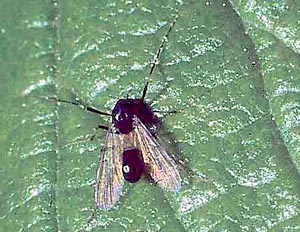Buffalo Gnats | |
|---|---|
| May 9, 2008 | |
|
We have received reports of buffalo gnats, also known as black flies, attacking people and poultry, particularly in central Illinois south to Calhoun County. Buffalo gnats are small, 1/16- to 1/8-inch-long, humpbacked black flies. They bite exposed skin, typically leaving a small, red welt. When the gnats are numerous, the toxins from their bites can kill poultry and other birds. They feed on the thinly haired areas of dogs, cats, and horses, such as ears and undersides. There are number of species that occur in Illinois, and some species are relatively specific to host. With this host specificity, one type of animal may be attacked much more than others. Only in the last couple of years have we had common human-biting species, and that has been reported already this year.  Buffalo gnats live as larvae in clear, fast-moving streams and feed by filtering food from the water. With the federal Clean Water Act and various other pollution-reducing measures, the streams, rivers, lakes, and ponds of Illinois are becoming clean enough to support life that has been much reduced since the 1930s. Adult buffalo gnats can fly from 7 to 15 miles from their source; but generally, Illinois residents that are bothered live within a half mile of the stream producing the flies. Although there are reports of DEET-containing insect repellents not being effective, scientific literature reports that DEET repellents provide the most effective protection. In areas with high populations of buffalo gnats, people commonly wear head nets, hats with insect protective netting that covers the head down to the shoulders. These are sold in sporting goods stores. Unlike mosquitoes, buffalo gnats do not bite through clothing, so only exposed skin is susceptible to attack. They also do not enter buildings. Controlling the buffalo gnats as larvae is generally not an option. Bacillus thuringiensis israeliensis (Bti) is effective against the larvae but is restricted by extensive regulation before it can be applied to running water. Other insecticide application would not only be in violation of federal and state laws but would likely kill fish and other wildlife. Running water is extensively protected by law because most running water eventually is used as human drinking water. If the buffalo gnats follow the pattern of previous years, they should be a problem for only 3 to 4 weeks and are not likely to return until next year. | |
| Author: | Phil Nixon |
